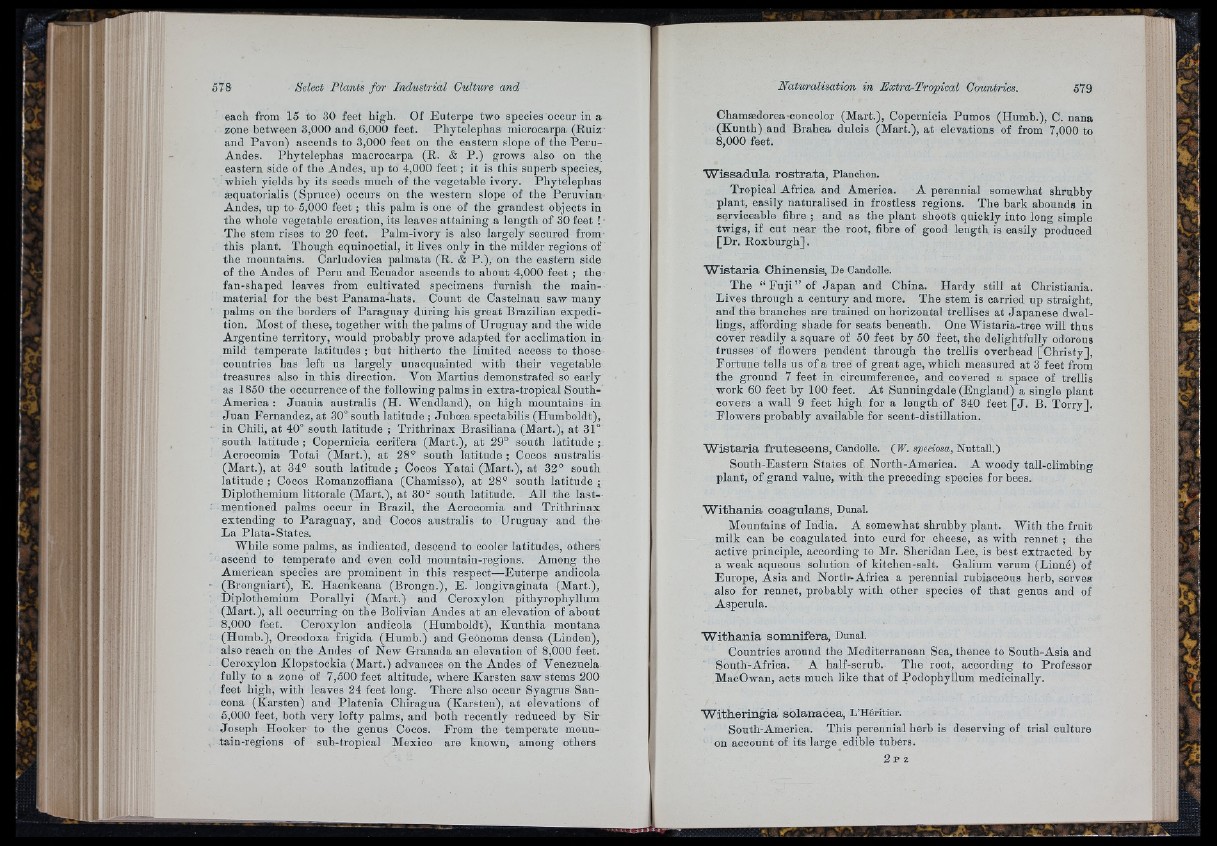
each from 15 to 30 feet high. Of Euterpe two species occur in a
zone between 3,000 and 6,000 feet. Phytelephas microcarpa (Ruiz
and Pavon) ascends to 3,000 feet on the eastern slope of the Peru-
Andes. Phytelephas macrocarpa (R. & P.) grows also on the
eastern side of the Andes, up to 4,000 feet ; it is this superb species,
which yields by its seeds much of the vegetable ivory. Phytelephas
æquatorialis (Sprnce) occurs on the western slope of the Peruvian
Andes, np to 5,000 feet ; this palm is one of the grandest objects in
the whole vegetable creation, its leaves attaining a length of 30 feet !
The stem rises to 20 feet. Palm-ivory is also largely secured from
this plant. Though equinoctial, it lives only in the milder regions of
the mountams. Carludovica palmata (R. & P .), on the eastern side
of the Andes of Peru and Ecuador ascends to about 4,000 feet ; the
fan-shaped leaves from cultivated specimens furnish the main-
material for the best Panama-hats. Count de Castelnau saw many
palms on the borders of Paraguay during his great Brazilian expedition.
Most of these, together with the palms of Uruguay and the wide
Argentine territory, would probably prove adapted for acclimation in
mild temperate latitudes ; hut hitherto the limited access to those
conntries has left us largely unacquainted with their vegetable
treasures also in this direction. Von Martius demonstrated so early
as 1850 the occurrence of the following palms in extra-tropical South-
America : Juania australis (H. Wendland), ou high mountains in
Ju a n Pernandez, at 30° south latitude ; Jubæa speotabilis (Humboldt),
in Chili, a t 40° south latitude ; Trithrinax Brasiliana (Mart.), a t 31°
south latitude ; Copernicia cerifera (Mart.), at 29° south latitude ;
Acrooomia Totai (Mart.), at 28° south latitude ; Cocos australis
(Mart.), a t 34° south latitude ; Cocos Yatai (Mart.), a t 32° south
latitude ; Cocos Romanzofflana (Chamisso), at 28° south latitude ;
Diplothemium littorale (Mart.), at 30° south latitude. All the last-
mentioned palms occur iu Brazil, the Acrocomia and Trithrinax
extending to Paraguay, and Cocos australis to Uruguay aud the
La Plata-States.
While some palms, as indicated, descend to cooler latitudes, others
ascend to temperate and even cold mountain-regions. Among the
American species are prominent in this respect—Euterpe andioola
(Brongniart), E. Haenkeana (Brongn.), E. longivaginata (Mart.),
Diplothemium Porallyi (Mart.) and Ceroxylon pithyrophyllum
(Mai't.), all occurring on the Bolivian Andes a t an elevation of about
8.000 feet. Ceroxylon andicola (Humboldt), Kunthia moutana
(Humb.), Creodoxa frigida (Humb.) and Geonoma densa (Linden),
also reach on the Andes of New Granada an elevation of 8,000 feet.
Ceroxylon Klopstockia (Mart.) advances on the Andes of Venezuela
fully to a zone of 7,500 feet altitude, where Karsten saw stems 200
feet high, with leaves 24 feet long. There also occur Syagrus San-
cona (Karsten) and Platenia Chiragua (Karsten), a t elevations of
5.000 feet, both very lofty palms, and both recently reduced by Sir
Joseph Hooker to the genus Cocos. From the temperate mountain
regions of sub-tropical Mexico are known, among others
Chamædorea-concolor (Mart.), Copernicia Pumos (Humb.), C. nana
(Kunth) and Brahea dulcis (Mart.), a t elevations of from 7,000 to
8,000 feet.
Wissadula rostrata, Planchón.
Tropical Africa and America. A perennial somewhat shrubby
plant, easily naturalised in frostless regions. The bark abounds in
serviceable fibre ; and as the plant shootS quickly into long simple
twigs, if cut near the root, fibre of good length is easily produced
[Dr. Roxburgh].
Wistaria Chinensis, De Candolle.
The “ F u j i” of Jap an and China. Hardy still a t Christiania.
Lives through a century and more. The stem is carried up straight,
and the branches are trained on horizontal trellises at Japanese dwellings,
affording shade for seats beneath. Cne Wistaria-tree will tlms
cover readily a square of 50 feet by 50 feet, the delightfully odorous
trusses of flowers pendent through the trellis overhead [Christy],
Fortune tells us of a tree of great age, which measured a t 3 feet from
the ground 7 feet in circumference, and covered a space of trellis
work 60 feet by 100 feet. A t Sunningdale (England) a single plant
covers a wall 9 feet high for a length of 340 feet [ J . B. Torry].
Flowers probably available for scent-distillation.
Wistaria frutescens, Candolle. (IT. speciosa, Nuttall.)
South-Eastern States of North-Amerioa. A woody tall-climbing
plant, of grand value, with the preceding species for bees.
Withania ooagulans, Dunal.
Mountains of India. A somewhat shrubby plant. With the fruit
milk can he coagulated into curd for cheese, as with rennet ; the
active principle, according to Mr. Sheridan Lee, is best extracted by
a weak aqueous solution of kitchen-salt. Galium verum (Linné) of
Europe, Asia and North-Africa a perennial rubiaceous herb, serves
also for rennet, probably with other species of that genus and of
Asperula.
Withania somnífera, Dunal.
Countries around the Mediterranean Sea, thence to South-Asia and
South-Africa. A half-scrub. The root, according to Professor
MacCwan, acts much like th a t of Podophyllum medicinally.
Witheringia solanacea, L’Héritier.
South-America. This perennial herb is deserving of trial cnlture
on account of its large edible tubers.
2 P 2